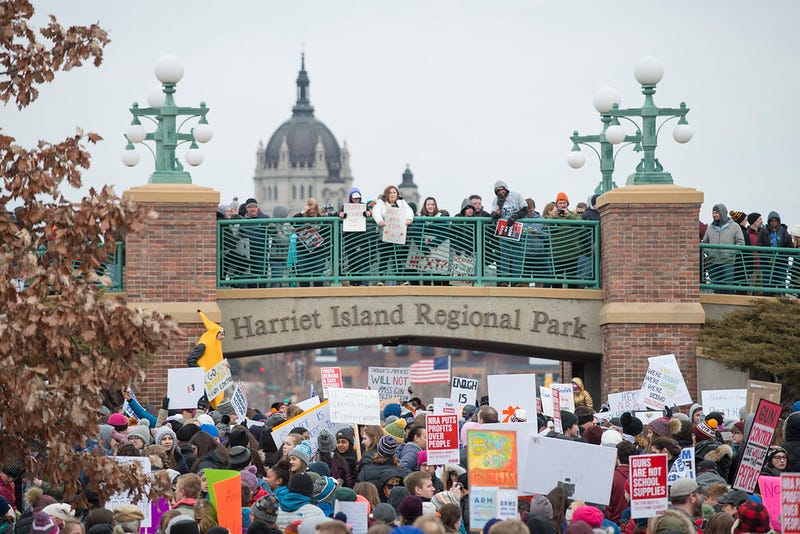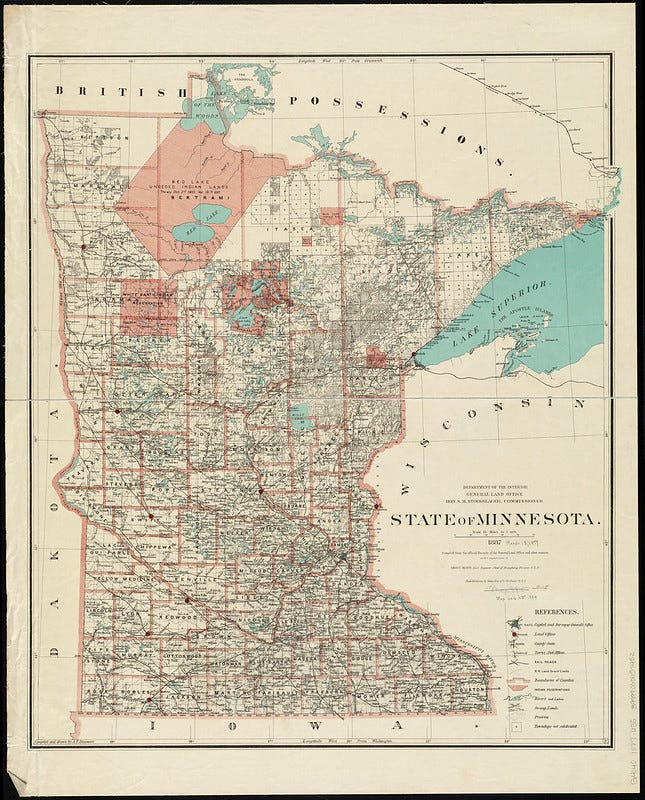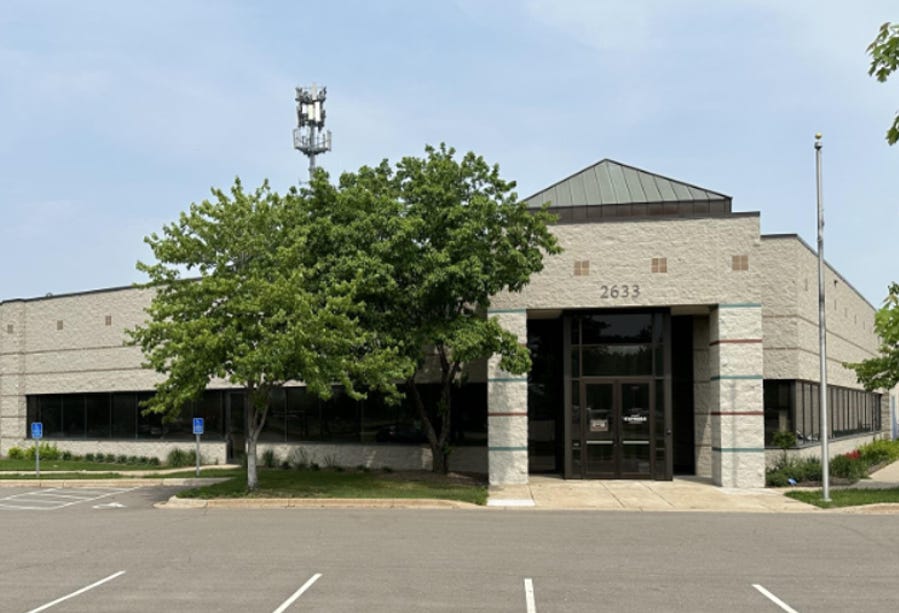#NoKings: What Happens Now?
Opposing Trump Isn’t Enough, Democrats Need to Appeal to a Wider Audience
Minneapolis Can Feel Like an Island, but It Isn’t
When we read stories in the national press, we often ask ourselves: how does this apply to Minneapolis? The answer isn’t always obvious. Our city can feel like an island unto itself — with debates and proposals that would gain little traction anywhere outside the most liberal enclaves in America.
Take Ward 2 Council Member Robin Wonsley’s campaign for re-election, which elevates the idea of a municipal grocery store. It’s a proposal that might raise eyebrows in most U.S. cities, but here, it’s part of a serious civic conversation about equity, access, and public control.
That sense of exceptionalism runs deeper than policy. For most cities, having police officers in a police station is an unremarkable fact of life. In Minneapolis, residents of the 3rd Precinct watched their station burn to the ground on May 28, 2020, just three days after George Floyd’s murder. More than five years later, the precinct still operates from a temporary site. At the same time, the planned South Minneapolis Community Safety Center — a facility meant to include both a police station and “other community resources” — remains months, if not years, from opening.
A small but vocal group of residents objected to calling the new facility a police station — and so it became a community safety center. This kind of semantic reframing may seem harmless, but to many voters it represents the sort of symbolic politics that’s driving people away from the DFL.
Nationally, Republicans are gaining ground in voter registration. According to NBC News, “Republicans have slashed a long-standing Democratic registration edge by more than 1 million just since last year’s election. This is a far cry from Trump’s first term, when the net shift to the GOP between the 2016 and 2018 elections was barely 100,000.”
Even as Donald Trump remains deeply polarizing, Democrats face their own popularity crisis. The No Kings rally was inspiring, but it must yield tangible results — like new voter registrations — if it’s going to help the party win back the White House. Without a course correction, Republicans could establish a long-lasting electoral advantage. That would be tragic, because their policies often harm the very communities Democrats claim to champion: those most in need of opportunity and stability.
The larger point is that Minneapolis continues to drift, moving from one well-intentioned initiative to the next without a clear plan or shared vision. The city — and by extension, the DFL — struggles to articulate goals and build consensus around them. Much of what emerges from the council reflects an ideology that seems to overlook a basic civic truth: residents want to feel safe, raise families, prosper economically, and find a community that reflects their values.
When politicians invoke “Minnesota values” or “Minneapolis values,” it’s often unclear what those values actually mean in practice. The DFL seems more focused on tearing itself apart than on crafting a moderate, unifying platform that could expand its base and preserve control of the governor’s office.
Look at the Entire Map
Keeping Minnesota in the blue column will require Minneapolis voters to recognize that electing candidates with the most uncompromising agendas risks alienating the independent and socially moderate residents whose votes are essential to prevent the state from turning red beyond a few bright-blue city dots.
One example came from The Opinions, a New York Times podcast that recently interviewed Democratic Senator Ruben Gallego of Arizona — who won even as his state voted for Trump. He did so by emphasizing prosperity over the more abstract language of equity — a term that often resonates less with voters outside academic or activist circles. Gallego’s victory offers a lesson in what it takes to win elections: clear goals, disciplined messaging, and a genuine understanding of the people you aim to represent.
Gallego earned attention for banning the term “Latinx” from his campaign, advocating stronger border enforcement, and rejecting guidance from nonprofit think tanks that presumed to know what Hispanic men wanted. He understood that many voters value economic opportunity — and yes, the pride of having a “giant truck” in the driveway, which to them, symbolized success. He didn’t try to convince them that their understanding of the American Dream was wrong; he spoke to it directly.
At its best, this is what effective representation looks like: affirming that prosperity, built through hard work and determination, remains a shared ideal. People crave the dignity that comes from knowing what they have, they’ve earned. Government’s role is to build the scaffolding that helps them climb toward those dreams.
Another item worth noting was a recent New York Times editorial titled, “The Partisans Are Wrong: Moving to the Center Is the Way to Win.”
The board’s analysis shows that in today’s political climate, moderate candidates fare better than those on the extremes — particularly in the swing states that determine national outcomes.
It’s worth pausing to clarify what “moderate” actually means, because it doesn’t mean standing still or waiting for Trump to fade from the scene. Here’s how the editorial board summarized the centrist consensus, based on recent polling:
Most voters prefer capitalism to socialism, worry that government is too big — and also believe that corporations and the wealthy hold too much power.
Most oppose both the harsh immigration enforcement of the Trump years and the lax Biden policies that led to record border crossings.
Most favor robust policing to combat crime and simultaneously reject police brutality.
Most support broad abortion access, with some restrictions later in pregnancy.
Most oppose race-based affirmative action but support class-based approaches.
Most favor job protections for transgender people and believe trans girls should not compete in girls’ sports.
Most want strong public schools and the flexibility to choose where their children attend.
These findings reflect a country that is neither left nor right in absolute terms — but pragmatic, conflicted, and yearning for balance.
The Moderate Minneapolis Agenda
It’s worth debating what a truly moderate agenda for the city should look like — but what’s clear is that one is needed. Promoting candidates who oppose progress at George Floyd Square or delay rebuilding the Southside Community Safety Center isn’t going to get us there.
Yes, we want accountable police — but we also need more of them. And we must recognize that law enforcement is only one side of the equation. There are also the individuals breaking into homes, smashing windows, selling drugs, and carrying weapons. These are people who have decided that the risks of crime are acceptable — often because other paths to prosperity or belonging feel closed to them.
Minneapolis needs candidates willing to speak to both sides of that equation. Yes, discuss diverting appropriate 911 calls away from MPD, but also talk frankly about the responsibility the community has in keeping children out of gangs and off the streets. Relying on the city or county to act as guardians is a losing strategy — one that leaves families, children, and neighborhoods to bear the cost.
When it comes to workers, let’s remember that fewer than 15% of residents belong to unions. While collective bargaining and fair wages are essential, much of the conversation about workers overlooks the 85% who depend on private employers and investment to support their families. Minneapolis must welcome businesses of all sizes so that there are economic opportunities for both new arrivals and lifelong residents.
The constant vilifying of businesses, builders, and investors may win applause in a city election, but it undermines the city’s long-term health. Attracting business investment is essential to creating high-wage jobs, expanding opportunity, and restoring a sense of security in Minneapolis. Programs like the oft-cited Vibrant Storefronts initiative are a temporary fix for much deeper structural wounds. Relying on government programs alone to rebuild this city — and make it a true center of energy, jobs, and innovation a decade from now — is unrealistic at best and damaging at worst.
Conclusion
The moderate mindset described by the New York Times editorial board reflects the values of many in this city. The Minneapolis DFL — weakened and directionless after its recent rebuke from the state party — may ultimately need to give way to something new. An independent movement focused on efficient governance, accountability, public safety, and economic opportunity could find real traction here.
What happens in Minneapolis reverberates far beyond our own neighborhoods. As we head into this election, we should ask which candidates will move the city toward sensible, unifying policies that can broaden the appeal of the DFL brand across Minnesota.
The best way to counter Republican momentum is to show that Democrats can govern Minneapolis with unity, efficiency, and a seriousness worthy of the city’s promise. In short, we need to get the basics right and deliver real improvements in residents’ quality of life.
Note: Mark your calendars for the October 30th Happy Hour.





Thank you for this thoughtful piece. I agree that moving more to the middle will widen the pool of voters and the chances of winning for the DFL. When you go to the extremes, there's simply less people to appeal to, and you become ultra-reliant on a small subset of people voting, which they don't always do, often times because these voters demand purity in ideology over willingness to compromise.
Ideologically pure candidates stay in office not because they're popular, but because of structural pieces such as gerrymandered districts (or city council wards) and the exclusionary, grueling and impossible-to-explain caucus process.
By the way, this plays out in both major parties. The Republicans in Minnesota are fighting their own civil war of far right purists vs more traditional candidates (Royce White anyone?). You don't hear about it as much in MN because mainstream media largely focuses on the DFL, and there's almost no coverage of municipal races in outstate Minnesota.
It's worth calling out the "small but vocal minority" in Minneapolis politics specifically. They're not hard to find. They appear in every single doorknocking photo for DSA candidates, they are staff members at prominent non-profits and labor unions, they write commentaries and letters to the editor in the Star Tribune weekly, and record videos and social media ads for Minneapolis for the Many. Some are political aides to current elected officials, and many of them are appointed to state, city, and county advisory bodies that 99% of people have never heard of, but nevertheless shape policy for years. Many are UMN Humphrey school graduates and have strong networks to find jobs and stay in the metro, continuing to influence public policy and discourse.
The small but vocal minority are dedicated and some make a living as political organizers. Others are simply passionate and believe they're doing the right thing. But they're organized and have built far stronger "bones" to maintain their influence; the "moderates" by contrast rely entirely on PAC money and many arguably weak candidates who have little to no connection to the ward or area they're running for.
If the moderates want to win, it goes beyond messaging. Moderates need to build a pipeline of candidates for mayor, city council, parks, BET, school board and state reps/state senate. They need to be appointed to advisory bodies and shape the discourse. They need to be active and present in their communities, and it's going to take years to do.
Great piece. I am disgusted by Trump, but I admire his ability to read the public. He understood that the majority was anxious about the cost of living and immigration - he perfectly played that anxiety (unfortunately, he is now overplaying). Returning to Minneapolis and our upcoming municipal elections, our candidates need to understand that leaders must be able to hold multiple thoughts in their heads at the same time. For example, hiring more cops, being tough on crime, developing alternative public safety concepts, and working to eliminate police brutality are not mutually exclusive. The NYT editorial board's summary you shared of the centrist consensus is so obvious that it is embarrassing that the DFL locally and the Dems nationally are so clueless. The Minneapolis DSA anti-capitalism is as misguided as MAGA's racist anti-immigration stance. Again, you can be anti-oligarchy and pro-capitalism. Thanks for this post!